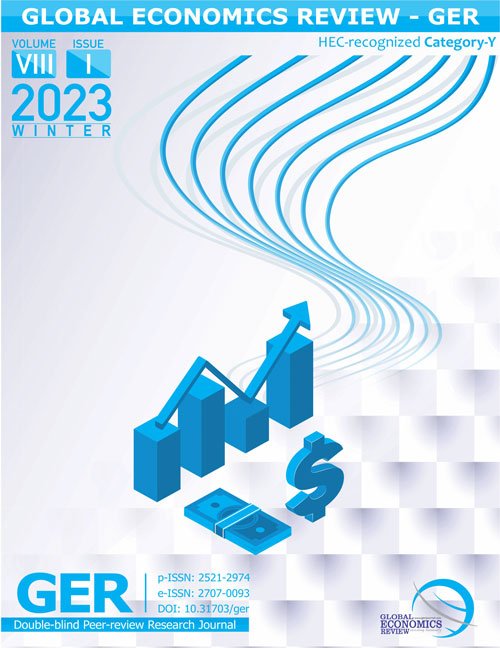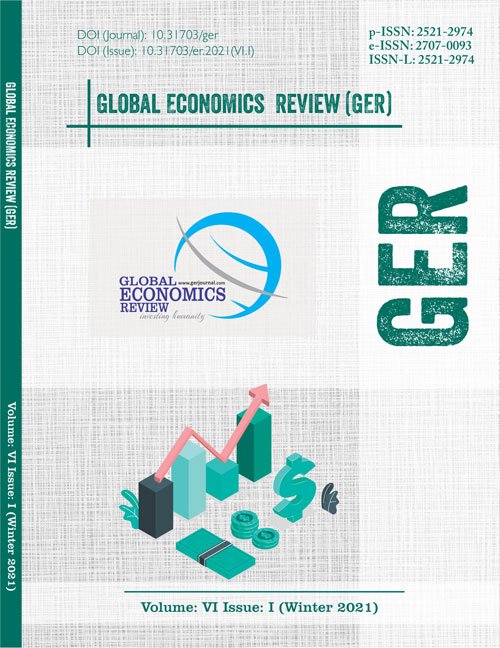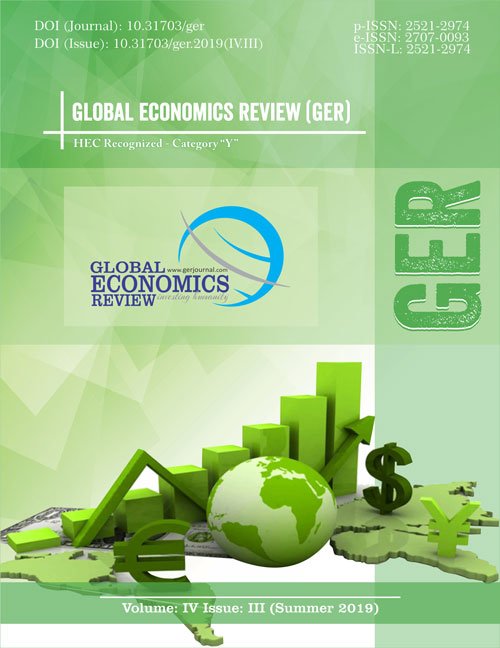01 - US-China Trade War and its Impact on Pakistan Exports
http://dx.doi.org/10.31703/ger.2020(V-III).0110.31703/ger.2020(V-III).01 Published : Sep 2020
-
This research study attempts to explore the effect of a trade war between the United States of America and China on Pakistan and other regional countries exports to the United States of America. The difference-in-difference methodology used to obtain the coefficients of each country to estimate the change in exports to the US from China, India, Bangladesh, and Pakistan. The empirical results indic... Details
-
Trade War, Trade Diversion, Tariffs, United States, China, Pakistan
-
(1) Zulfiqar Ali Keeryo
Ex. Economic Growth Advisor, Research and Training Wing, Planning and Development Department, Government of Sindh, Pakistan.
(2) Jazib Mumtaz
PhD Scholar, Department of Social Sciences (Economics), Shaheed Zulfikar Ali Bhutto Institute of Science and Technology, Karachi, Sindh, Pakistan.
(3) Allah Bux Lakhan
PhD Scholar, Department of Economics, Shah Abdul Latif University, Khairpur, Sindh, Pakistan.
02 - Climatic Changes Effects on Agricultural Production: An Assessment in Case of Pa
http://dx.doi.org/10.31703/ger.2020(V-III).0210.31703/ger.2020(V-III).02 Published : Sep 2020
-
The emission of carbon from electricity, gas fuel consumption, residential building and commercial buildings has raised the temperature of the region, affecting agricultural production. The agaric sector is sensitive to change in temperature. This paper examines the climatic variations due to CO2 emission from different sources is inclined to the yield of production by taking time series data over... Details
-
Crop production, Temperature, CO2 from Residential Buildings, CO2 Emission from electricity and Heat, Air Pollution from Carbon Emission, Environmental Pollution, Tariffs, United States, China, Pakist
-
(1) Muhammad Shahid
Assistant Professor, Head of Economics Department, Govt. Post Graduate College Bhakkar, Punjab, Pakistan.
(2) M. Niamatullah
Head, Department of Economics, Gomal University, Dera Ismail Khan, KP, Pakistan
(3) Bibi Aisha Sadiqa
Assistant Professor, Department of Economics, Hazara University, Mansehra, KP, Pakistan
03 - Impact of Foreign Aid on Health Sector of Pakistan
http://dx.doi.org/10.31703/ger.2020(V-III).0310.31703/ger.2020(V-III).03 Published : Sep 2020
-
Foreign-Aid is considered a key to economic growth in developing countries. Governments of developing countries are not able to fulfil the requirements of development. Official Development Assistant is used as supplements of domestic resources, and it plays a vital role in the bridge the gap of the budget deficit. Health is the main contributor to economic growth. Like other sectors, Pakistan reli... Details
-
Foreign Aid, Health Sector, ARDL, Investment, Openness
-
(1) Aftab Anwar
Assistant Professor, University of Education, Lahore, Punjab, Pakistan.
(2) Ghulam Yahya Khan
Assistant Professor, Kashmir Institute of Economics, University of Azad Jammu & Kashmir, Muzaffarabad, Kashmir, Pakistan.
(3) Muhammad Masood Anwar
PhD Scholar, Kashmir Institute of Economics, University of Azad Jammu & Kashmir, Muzaffarabad, Kashmir, Pakistan.
04 - Polio Eradication Media Campaign in Pakistan: KAP Analysis in Punjab
http://dx.doi.org/10.31703/ger.2020(V-III).0410.31703/ger.2020(V-III).04 Published : Sep 2020
-
The aim of this research is to go through the effects of media health campaigns on knowledge, attitude and practices regarding the disease of Polio in province Punjab. The data was collected from 500 respondents from 35 districts of Punjab. The quantitative findings of the study proved that media, particularly TV is the main source of health information in both urban and rural areas. The practice ... Details
-
Polio, Health, Media, Awareness, Punjab
-
(1) Irem Sultana
Assistant Professor, Department of Mass Communication, Government College University, Faisalabad, Punjab, Pakistan.
(2) Rao Shahid Mahmood Khan
Assistant Professor, Department of Media Studies, The Islamia University of Bahawalpur, Punjab, Pakistan.
(3) Malik Adnan
Assistant Professor, Department of Media Studies, The Islamia University of Bahawalpur, Punjab, Pakistan.
05 - Asymmetries in Response to Shocks in Price Setting: Firm-Level Evidence from Sur
http://dx.doi.org/10.31703/ger.2020(V-III).0510.31703/ger.2020(V-III).05 Published : Sep 2020
-
The objective of the paper is to estimate the asymmetric response of firms for prices to supply and demand shocks. Firms give an asymmetric response to supply and demand shocks while setting at a price, and the prices are upward flexible and downward rigid to changes in the determinants. Asymmetric response to the cost of raw material is highest. Moreover, the seasonal factors have the lowest degr... Details
-
Supply and Demand Shocks, Asymmetric Response and Price Setting
-
(1) Nadeem Iqbal
Assistant Professor, Department of Economics, University of Peshawar, KP, Pakistan.
(2) Amjad Amin
Assistant Professor, Department of Economics, University of Peshawar, KP, Pakistan.
(3) Danish Wadood Alam
Lecturer, Department of Economics, University of Peshawar, KP, Pakistan.
06 - Determinants of Corporate Cash Holdings in Hospitality Sector of France, Spain a
http://dx.doi.org/10.31703/ger.2020(V-III).0610.31703/ger.2020(V-III).06 Published : Sep 2020
-
This study determines the effect of parameters used for cash holding in hospitality sector (HS) of target countries i-e France, Spain and United State of America for the period of 14 years (2005-2018). The parameters consist of firm size, leverage, capital expenditure, growth opportunity, liquidity, cash flow, cash flow volatility, asset intangibility, dividend payments and stock exchange. Dynamic... Details
-
Cash Holdings, Hospitality, Unique Attributes
-
(1) Majid Mumtaz
IBL, Abdul Wali Khan Univerity, Mardan, KP, Pakistan
(2) Wisal Ahmad
Assistant Professor, Institute of Business Studies & Leadership, Abdul Wali Khan University Mardan, KP, Pakistan.
(3) Syed Arshad Ali Shah
Lecturer, Bacha Khan University, Charsadda, KP, Pakistan.
07 - Impact of Cramel Model on the Financial Performance of Commercial Banks in Pakis
http://dx.doi.org/10.31703/ger.2020(V-III).0710.31703/ger.2020(V-III).07 Published : Sep 2020
-
This paper analyzes the impact of CRAMEL model on commercial banks financial performance working in Pakistan. Firm financial performance used as dependent variable e.g. ROA, ROE and TQ whereas Capital Adequacy, Resource Allocation, Asset Quality, Management Efficiency, Earning Profitability and Liquidity were used as independent variables. Panel data was analyzed through ordinary least square, fix... Details
-
Return on Assets, Return on Equity, Capital Adequacy, Resource Allocation, Asset Quality, Management Efficiency, Earning Profitability, Liquidity, Pakistan Stock Exchange
-
(1) Syed Masood Shah
MS Management Science, Abdul Wali Khan University Mardan, KP, Pakistan.
(2) Muhammad Faizan Malik
Assistant Professor, Abdul Wali Khan University Mardan, KP, Pakistan.
(3) Sikandar Shah
MS Management Science, Abdul Wali Khan University Mardan, KP, Pakistan.
08 - Co-Movement of Forex Rate and Share Price of Pakistan Stock Exchange - An Applic
http://dx.doi.org/10.31703/ger.2020(V-III).0810.31703/ger.2020(V-III).08 Published : Sep 2020
-
This paper examines the relationship between the forex rate and the share price of the Pakistan Stock Exchange. The study provides additional understating of the complex nature of the relationship among bi-variate time series using the Copula model. Copula models are best suited to find the co-movement of time series data integrating the possible latent structure of the relationship through estima... Details
-
Copula Model, Share Price, Forex rate, Joint Distribution
-
(1) Muhammad Nouman Latif
Department of Mathematics and Statistics, Pir Mehr Ali Shah Arid Agriculture University, Rawalpindi, Punjab, Pakistan.
(2) Nasir Ali
Department of Mathematics and Statistics, Pir Mehr Ali Shah Arid Agriculture University, Rawalpindi, Punjab, Pakistan.
(3) Anjum Shahzad
Department of Mathematics and Statistics, Pir Mehr Ali Shah Arid Agriculture University, Rawalpindi, Punjab, Pakistan.
09 - Role of Mass Media in Dissemination of Agricultural Information among Farmers of
http://dx.doi.org/10.31703/ger.2020(V-III).0910.31703/ger.2020(V-III).09 Published : Sep 2020
-
This study inspects the role of mass media in terms of spreading information related to agricultural activities in Hyderabad district (Sindh) Pakistan. It also aims to explore the most preferred medium of information among farmers. Three areas including Tando Jam, Hosri and Hatri are chosen from Hyderabad district. The total sample data collected through purposive sampling technique from 180 farme... Details
-
Mass Media, Agricultural Information, Farmers, Dissemination
-
(1) Shazia Shahab Shaikh
Assistant Professor, Department of Media & Communication Studies, University of Sindh, Jamshoro, Sindh, Pakistan.
(2) Ali Hassan
Lecturer, Department of Media Studies, The Islamia University of Bahawalpur, Punjab, Pakistan.
(3) Yasmeen Sultana Forooqui
Associate Professor, Department of Media Sciences, Ilma University Karachi, Sindh, Pakistan.
10 - Household Poverty, Women Fertility and Child Nutritional Status in Tehsil Jahani
http://dx.doi.org/10.31703/ger.2020(V-III).1010.31703/ger.2020(V-III).10 Published : Sep 2020
-
This study measures the impact of household poverty on women fertility and the nutritional status of children. In this study, the poverty level is computed by the per capita income, while women fertility is measured by the number of children in a household. The Height- for-age Z-score (HAZ) method has been used to measure the nutritional status of children. A survey has been conducted to collect h... Details
-
Household Poverty, Women Fertility and Child Nutritional Status
-
(1) Muhammad Ramzan Sheikh
Associate Professor, School of Economics, Bahauddin Zakariya University Multan, Punjab, Pakistan.
(2) Muhammad Tariq
Lecturer, Department of Economics, Bahauddin Zakariya University Multan, Punjab, Pakistan.
(3) Maryam Ghafoor
MPhil Student, School of Economics, Bahauddin Zakariya University Multan, Punjab, Pakistan.
11 - Examining the Impact of Information and Communication Technologies on Female Eco
http://dx.doi.org/10.31703/ger.2020(V-III).1110.31703/ger.2020(V-III).11 Published : Sep 2020
-
This study is an attempt to investigate the impact of information and communication technologies (ICTs) development on the participation of women in economic activities in Pakistan. Data for the period 1991-2017 was used for this research work and regressed on female economic involvement and ICTs development and another set of control variables like GDP, FDI and trade liberalization. Data sources ... Details
-
ICTs, Female Participation, GDP, FDI, Developing Countries, Pakistan
-
(1) Sabahat Akram
Associate Professor, Department of Economics, University of Kotli, Azad Jammu & Kashmir, Pakistan.
(2) Hajra Faraqat
MS Scholar, Department of Economics, University of Kotli, Azad Jammu & Kashmir, Pakistan.
(3) Saadia Bano Hashmi
Assistant Professor, Department of Governance and Public Policy, National University of Modern Languages, Islamabad, Pakistan.
12 - COVID-19: Socio-Economic Implications for Pakistan
http://dx.doi.org/10.31703/ger.2020(V-III).1210.31703/ger.2020(V-III).12 Published : Sep 2020
-
The paper analyzes the global pandemic of COVID-19, its evolution, development and its implications on the world and specifically Pakistan. Sparkly, it emerged in the Chinese city of Wuhan, was restricted to the city for less than a month, but currently, the virus has engrossed the whole world. This part of the study investigates both developed and developing countries responses to deal with the d... Details
-
Covid-19, Pakistan, Pandemic, Scio-Economic Implications, China, Responses
-
(1) Ijaz Khalid
Demonstrator, Department of Political Science, Abdul Wali Khan University Mardan. KP, Pakistan.
(2) Aneela Akbar
Demonstrator, Department of Political Science, Abdul Wali Khan University Mardan. KP, Pakistan.
(3) Hina Malik
Demonstrator, Department of Political Science, Abdul Wali Khan University Mardan. KP, Pakistan.
13 - BRICS and Evolving Trends of Complex Interdependence: Implications for Pakistan
http://dx.doi.org/10.31703/ger.2020(V-III).1310.31703/ger.2020(V-III).13 Published : Sep 2020
-
By far, the Realist notion of Power politics has remained the dominant paradigm in examining interstate relations; however, I want to argue that the evolving international landscape is moving fast towards complex interdependence. The peaceful rise of China, recurrence of Russia and rising Indian stature with a stable economic outlook and human capital of over 1 billion are hard facts, which is tra... Details
-
Complex Interdependence, Economic Integration, Power Politics
-
(1) Waseem Ishaque
Assistant Professor, Department of International Relations, National University of Modern Languages (NUML), Islamabad, Pakistan.
(2) Shabnam Gul
Assistant Professor, Department of Political Science, Lahore College for Women University, Lahore, Punjab, Pakistan.
(3) Muhammad Faizan Asgher
MPhil, Peace & Counter Terrorism Studies, Minhaj University Lahore, Punjab, Pakistan.
14 - An Empirical Investigation on Corporate Governance: Evidence from Pakistan
http://dx.doi.org/10.31703/ger.2020(V-III).1410.31703/ger.2020(V-III).14 Published : Sep 2020
-
This study aims to examine the association between firm performance and ownership structure. We collect the data from the annual reports of 60 random firms, which are listed in the Karachi stock exchange (KSE 100 Index), for a period of 5 years from 2007-2011. Firm performance is measured by using market and accounting based proxies, Tobin's Q, ROA, and ROE, respectively, while ownership structure... Details
-
Ownership Structure, ROA, ROE, Leverage
-
(1) Ghulam Nabi
Assistant Professor, Department of Business Administration, University of Kotli, AJ&K, Pakistan.
(2) Faheem Ghaznafar
Assistant Professor, Department of Business Administration, University of Kotli, AJ&K, Pakistan.
(3) Tahira Asif
MS Scholar, Department of Management Sciences, The Agriculture University Peshawar, KP, Pakistan.
15 - Investigating the Factors Affecting Female Work Participation in Pakistan: A Cas
http://dx.doi.org/10.31703/ger.2020(V-III).1510.31703/ger.2020(V-III).15 Published : Sep 2020
-
The present study sheds light on the factors affecting female work participation in the Multan division, being part of Southern Punjab, Pakistan. Empowering females economically may uplift the standard of living of their families as well as helps to reduce the poverty rates in the economy. Female labor force participation also contributes to improving the human capital of the less developed countr... Details
-
Female Work Participation, Education, Multan, Pakistan, Labor Supply
-
(1) Salyha Zulfiqar Ali Shah
Assistant Professor, School of Economics, Bahauddin Zakariya University Multan, Punjab, Pakistan.
(2) Umber Riaz
PhD Scholar, Institute of Social and Cultural Studies, Bahauddin Zakariya University Multan, Punjab, Pakistan.
16 - The Primary Modes of Islamic Finance: A Critical Analysis
http://dx.doi.org/10.31703/ger.2020(V-III).1610.31703/ger.2020(V-III).16 Published : Sep 2020
-
This paper is an attempt to analyze the practices of Mudarabah and Musharakah been held by the existing Islamic banking. This paper aims to explore the different aspects where Islamic banks were found to be violating the basic rules in these two primary modes of Islamic finance. This paper denies the current practices of Mudarabah and Musharakah at many grounds, like its existence with the concept... Details
-
Islamic Finance, Mudarabah, Musharakah, ShariâÃâ¬Ãâ¢ah
-
(1) Minhajuddin
Assistant Professor, Department of Economics, Faculty of Business and Economics, Abdul Wali Khan University Mardan, KPK, Pakistan
(2) Brekhana Gul
Lecturer, Department of Economics, Faculty of Business % Economics, Abdul Wali Khan University Mardan, KP, Pakistan
(3) Muhammad Sohail Alam Khan
Lecturer, Department of Economics, Faculty of Business % Economics, Abdul Wali Khan University Mardan, KP, Pakistan

 Volume X, Issue II (Spring 2025)
Volume X, Issue II (Spring 2025)  Volume IX, Issue III (Summer 2024)
Volume IX, Issue III (Summer 2024)  Volume IX, Issue II (Spring 2024)
Volume IX, Issue II (Spring 2024)  Volume IX, Issue I (Winter 2024)
Volume IX, Issue I (Winter 2024)  Volume VIII, Issue IV (Fall 2023)
Volume VIII, Issue IV (Fall 2023)  Volume VIII, Issue III (Summer 2023)
Volume VIII, Issue III (Summer 2023)  Volume VIII, Issue II (Spring 2023)
Volume VIII, Issue II (Spring 2023)  Volume VIII, Issue I (Winter 2023)
Volume VIII, Issue I (Winter 2023)  Volume VII, Issue IV (Fall 2022)
Volume VII, Issue IV (Fall 2022)  Volume VII, Issue III (Summer 2022)
Volume VII, Issue III (Summer 2022)  Volume VII, Issue II (Spring 2022)
Volume VII, Issue II (Spring 2022)  Volume VII, Issue I (Winter 2022)
Volume VII, Issue I (Winter 2022)  Volume VI, Issue IV (Fall 2021)
Volume VI, Issue IV (Fall 2021)  Volume VI, Issue III (Summer 2021)
Volume VI, Issue III (Summer 2021)  Volume VI, Issue II (Spring 2021)
Volume VI, Issue II (Spring 2021)  Volume VI, Issue I (Winter 2021)
Volume VI, Issue I (Winter 2021)  Volume V, Issue IV (Fall 2020)
Volume V, Issue IV (Fall 2020)  Volume V, Issue III (Summer 2020)
Volume V, Issue III (Summer 2020)  Volume V, Issue II (Spring 2020)
Volume V, Issue II (Spring 2020)  Volume V, Issue I (Winter 2020)
Volume V, Issue I (Winter 2020)  Volume IV, Issue IV (Fall 2019)
Volume IV, Issue IV (Fall 2019)  Volume IV, Issue III (Summer 2019)
Volume IV, Issue III (Summer 2019)  Volume IV, Issue II (Spring 2019)
Volume IV, Issue II (Spring 2019)  Volume IV, Issue I (Winter 2019)
Volume IV, Issue I (Winter 2019)  Volume III, Issue II (Fall 2018)
Volume III, Issue II (Fall 2018)  Volume III, Issue I (Spring 2018)
Volume III, Issue I (Spring 2018)  Volume II, Issue I (Fall 2017)
Volume II, Issue I (Fall 2017)  Volume I, Issue I (Fall 2016)
Volume I, Issue I (Fall 2016)